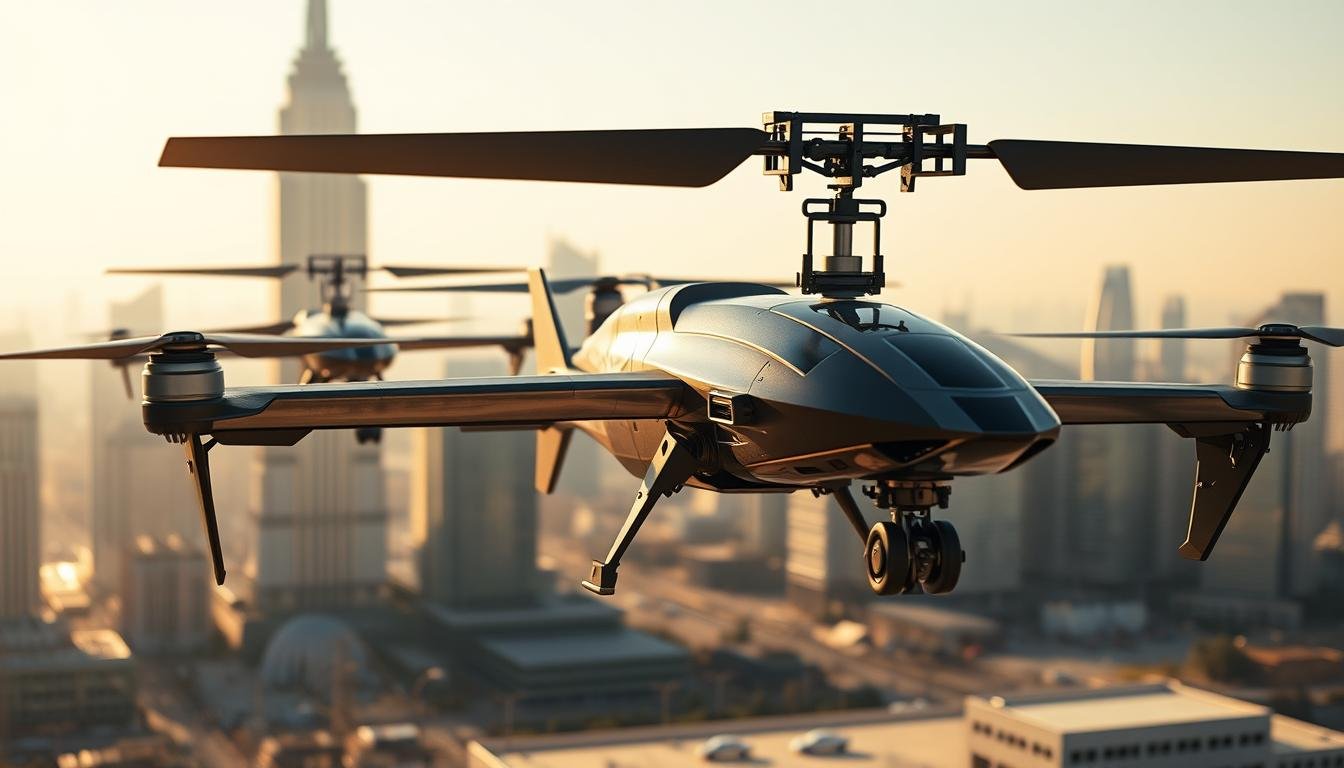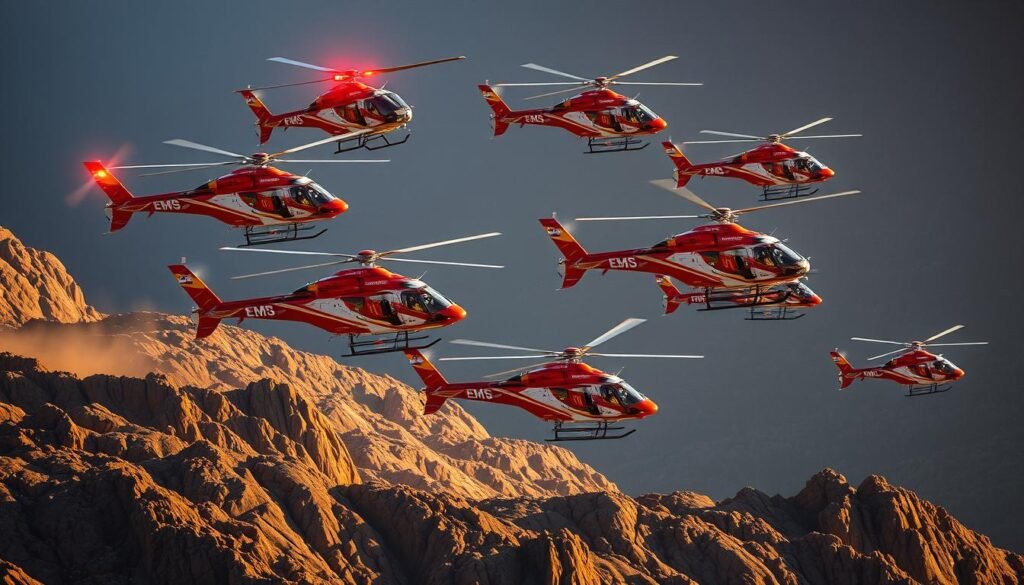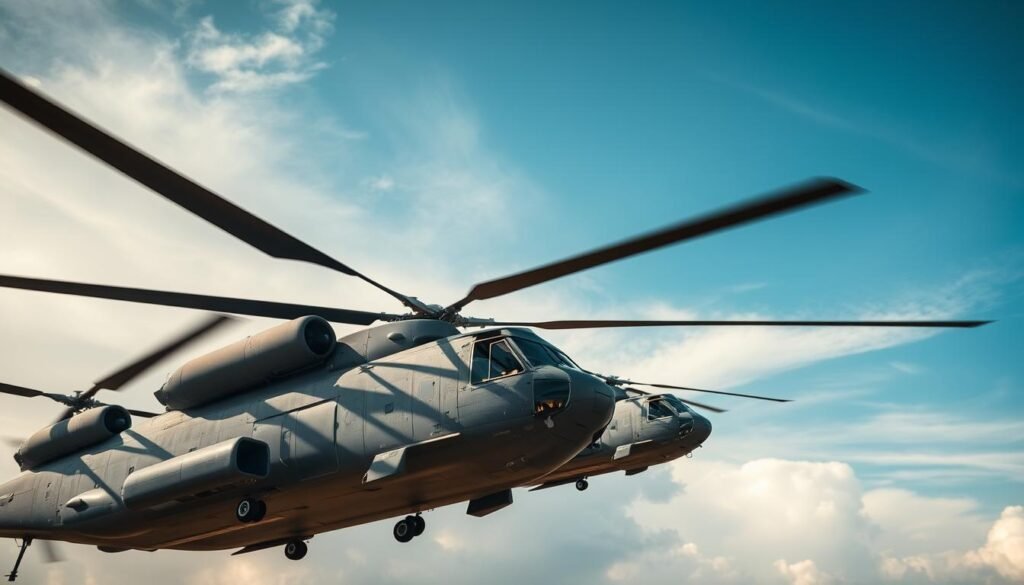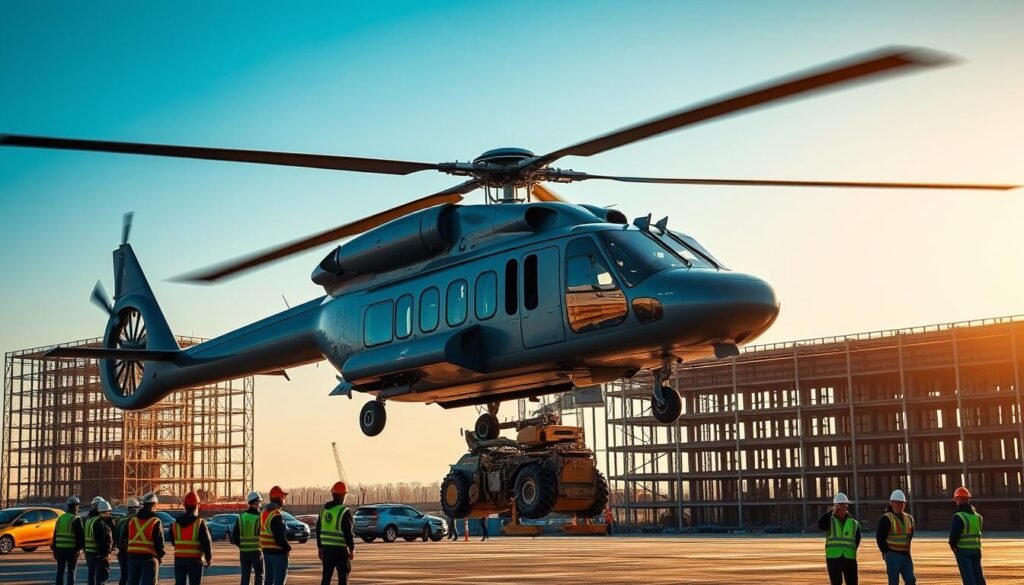Helicopter Drones framed the news agenda today with a fact few expected: heavy‑lift unmanned rotorcraft logged export‑capable endurance near 50 minutes and BVLOS ranges beyond 50 miles in trials.
The platforms, like the R550 Airtruck and R550 Sprayhawk, reached 14,000 ft MSL and carried full‑authority fly‑by‑wire controls, multi‑directional cameras, lidar and radar altimeters. They used resilient comms such as 2.4 GHz LOS, dual 4G/LTE and Starlink Mini, showing how an aircraft can keep mission links alive across long flight profiles.
Regulatory paths varied: the U.S. noted Experimental Category status while countries such as Brazil moved toward commercial approvals. Airbus’ HTeaming advances and a May 2025 test with a Spanish Navy H135 signaled real progress in crewed‑uncrewed teaming. This information shows how the world is shifting service delivery from demos to repeatable mission packages and how the near future will blend autonomy with human oversight.
Key Takeaways
- Endurance and range now support long BVLOS missions for heavy payloads.
- Advanced sensors and resilient communications improve flight safety and data fidelity.
- Regulatory status varies; the U.S. remains cautious while some countries allow commercial use.
- HTeaming and interoperability reduce crew workload and speed adoption.
- Operators view these aircraft as force multipliers across civil and defense roles.
- Service models are moving from trials to repeatable mission packages.
Helicopter Drones Lead Today’s Unmanned Flight Updates
New flight updates documented systems logging near 50 minutes of endurance and reliable beyond‑visual‑line‑of‑sight ranges. These demonstrations paired full‑authority fly‑by‑wire control with Starlink Mini and multi‑link comms to keep missions connected.
Breaking Developments Around The World
Around the world, trials validated helicopters and drones in harsh weather and complex terrain. Operators highlighted measurable gains in endurance and repeatable launch‑and‑recover cycles per unit time.
Why Rotorcraft Autonomy And Control Matter Now
Companies prioritized resilient communications, using dual LTE with satellite backhaul to hedge against RF congestion during complex operation. Autonomy packages were tested for terrain avoidance, automated holds, and smart return‑to‑home when links degraded.
| Aspect | Notable Result | Operational Impact |
|---|---|---|
| Endurance & Range | ~50 min; BVLOS >50 mi | Longer sorties, wider coverage |
| Comms | Dual LTE + Starlink Mini | Resilient links in congested areas |
| Interoperability | Level 4 live teaming | Cross‑vendor control, shared SA |
| Control Laws | Flight‑proven hover & approach | Precise low‑speed work in urban/maritime |
Notable test: Airbus reported Level of Interoperability 4 evaluations and a May 2025 test with a Spanish Navy H135 and Airbus Flexrotor, underscoring standardized protocols across platforms.
Helicopter Drones
The R550 class demonstrated that heavy‑lift unmanned rotorcraft can combine full‑authority fly‑by‑wire with a rich sensor suite to support industrial and agricultural missions.

Key Terms, Mission Profiles, And How They Differ From Multirotors
Configuration and Endurance: A single‑main‑rotor plus tail‑rotor layout delivers higher payload fraction and longer sorties than multirotor designs. That architecture enabled energy corridor surveys and extended spray runs without frequent refuel stops.
Flight Control And Software: Separating flight control from payload management let operators layer stability augmentation and waypoint navigation with terrain awareness. Open interfaces in the software roadmap enabled easy integration with mapping and spraying toolchains.
- Hover and Autorotation: As a rotorcraft, hover efficiency and autorotation behavior required different contingency procedures than multirotors.
- Operational Profiles: Missions included firefighting support, agricultural spraying, and inspection tasks where precise airspeed and altitude hold are critical.
- Pilot Role: The pilot focused on procedure adherence, pre‑mission setup, and emergency authority while routine legs shifted to autonomous modes.
Performance And Capabilities: Heavy‑Lift Helicopter Drone Systems
R550 variants delivered a mission profile that balanced long sortie time with high useful load for industrial and agricultural work.
Endurance, Range, And Altitude: 50 Minutes, BVLOS > 50 Miles, 14,000 Feet MSL
The Airtruck and Sprayhawk achieved about 50 minutes endurance and an operational range beyond 50 miles BVLOS. They reached a 14,000 ft MSL ceiling, expanding seasonal mountain missions.
Payload And Useful Load: From 1,102 Pounds To 110 Gallons For Spray Missions
The Airtruck carries a 1,102 lb useful load; the Sprayhawk swaps that for 110 gallons of spray. That capacity reduces turnbacks and boosts time on task for seeding, spraying, and inspection flights.
Fly‑By‑Wire Control, Sensors, And Communications Including Starlink Mini
Full‑authority fly‑by‑wire improved lateral and vertical control during gusts and close‑clearance work. The sensor stack includes forward, side and downward cameras, radar altimeter and terrain lidar.
Autopilot Modes And Autonomy: Stability Augmentation To Waypoint Navigation
Always‑on Stability Augmented mode and ACVH/TRC profiles pair with waypoint navigation and terrain‑avoidance autonomy. These systems standardize repeatable flight legs for safer operation.
“Full‑authority flight control and redundant links let the platform keep mission tempo high across long BVLOS legs.”

Crewed‑Uncrewed Teaming Sets A New Benchmark
Crews began treating unmanned assets as coordinated wingmen rather than isolated tools. Trials showed scaling from one piloted aircraft paired with a single drone to swarm tactics and air-launched effects. These changes reframed mission planning and risk management.
From One Crew-Pair To Swarms And Air-Launched Effects
Operational profiles expanded quickly. Crewed platforms first coordinated one remote asset and then added multiple assets to extend sensing and reach. That progression let crews keep distance while applying effects at stand-off ranges.
HTeaming Tablet: In-Flight Command, Reduced Workload, And Mission Software
The Airbus HTeaming tablet combined an enhanced HMI, mission software, modem and four antennas into a modular package. It let the crew enter command inputs, task routes and set payloads without distracting from core aviating duties.

Interoperability Progress: Level Of Interoperability 4 And Cross-Company Control
The European MUSHER project proved Level Of Interoperability 4. A remote asset was controlled from a piloted platform using standardized protocols. Cross-vendor control within a shared mission picture became a practical option.
Successful Test: Spanish Navy H135 And Airbus Flexrotor Demonstration
A May 2025 successful test paired a Spanish Navy H135 military helicopter with an Airbus Flexrotor. The trial validated cockpit-to-UAS links, latency margins, and clear division of duties in a maritime envelope.
The Role Of AI: Collaborative Decision-Making And Processed Information
AI filtered sensor feeds and delivered only actionable alerts to the crew. That preserved cognitive bandwidth and cut workload during dynamic phases. System architectures also included degraded-communications modes and traceable control handovers.
“Standardized control frameworks and intuitive tablet interfaces let crews scale teaming while keeping mission risk measurable.”
- Scalable Teaming: From single pairing to coordinated swarms and air-launched effects.
- Human-Machine Interface: Tablet-led command reduces manual tasking and streamlines contingencies.
- Resilience: Built-in fail-safes kept control authority recoverable under degraded links.
Operations And Missions Expanding Across Sectors
Practical deployments showed these rotor platforms delivering repeatable missions for utilities, firefighting, and crop care.

Energy, Utilities, And Construction Operations
Utility operators leveraged long BVLOS range to inspect pipelines and transmission lines across wide corridors. Precision hover reduced the need for man‑basket access and cut ground risk.
Construction teams used stable low‑speed flight to stage sensors and capture as‑built verification with repeatable capture geometries.
Firefighting, Disaster Response, And Unmanned Payload Testing
Fire support combined mapping, real‑time video and thermal cues to keep incident command informed while maintaining safety buffers over active lines.
Disaster teams used lift capacity for medical kits and comms relays to restore service when roads failed. Unmanned payload testing benefited from stable platforms for gimbals, LiDAR, and RF packages without risking crewed assets.
Agricultural Missions: Row Crop Spraying, Spreading, And Frost Protection
Ag operators executed row crop spraying with automated pattern following and terrain compensation. That kept application rate consistent across uneven fields and variable winds.
Long sorties let teams cover multiple fields before refuel, raising daily productivity while holding droplet and swath quality targets.
| Sector | Task | Operational Benefit | Primary Role |
|---|---|---|---|
| Utilities | Pipeline & Transmission Inspections | BVLOS range, reduced ground exposure | Observer / Pilot |
| Fire & Disaster | Mapping, Lift, Relays | Real‑time situational awareness, rapid delivery | Remote Pilot / Incident Command |
| Agriculture | Row Spraying, Spreading, Frost Protection | Consistent application rate, multi‑field sorties | Operator / Loader |
| Testing & Inspection | Gimbals, LiDAR, RF Trials | Stable platform for iterative tests | Test Pilot / Engineer |
Standardized procedures defined pilot, visual observer, and loader roles to align checklists and preserve safety during rapid turnarounds.
Platforms Landscape: Notable Unmanned Helicopters And Rotorcraft
A representative roster of aircraft covers lightweight ISR craft to heavy‑lift workhorses. Names include Airbus VSR700, Boeing A160 Hummingbird, Kaman K‑MAX, Schiebel Camcopter S‑100, UMS Skeldar V‑200, Northrop Grumman MQ‑8 Fire Scout/MQ‑8C, Yamaha R‑MAX, and Canadair CL‑227 Sentinel.
These platforms show how companies pursued varied propulsion, avionics, and payload integration paths. Some product lines focused on maritime fit—deck handling, folding rotors, and corrosion protection—while others emphasized dustproofing and fuel filtration for inland use.
Operational traits shaped procurement choices. Autorotation capability, maintenance cycles, and lifecycle costs drove estimates for mission availability.
Systems with mature logistics, training, and spare chains fielded faster for agencies that needed near‑term impact. The K‑MAX and S‑100 proved versatile in sling tasks and ISR roles.
- Product differentiation: deck fit and handling vs. land durability.
- Integration: common control stations and payload APIs ease cross‑platform use.
- Roadmaps: persistent payload power, open mission computers, and SATCOM options extend theater relevance.
“Buyers compared weight class, endurance, and data‑link resilience to match platforms to their concept of operations.”
Regulatory, Safety, And Crew Considerations In The United States
In the United States today, R550 platforms operated under Experimental Category rules that required staged approvals and clear risk mitigations.
The framework demanded documented crew roles and defined command‐and‐control envelopes before expanded operations were authorized.
Experimental Category, BVLOS Constraints, And Recommended Crew Roles
Crewing typically paired a remote pilot with a visual observer to maintain continuous airspace scanning and defined transfer‑of‑control procedures during handoffs.
For spraying missions, teams added a loader to manage tanks and fueling. That role reduced ramp exposure and sped turnarounds.
Regulators required system reliability evidence from ground and flight test artifacts to support BVLOS requests in defined corridors.
Safety cases emphasized geo‑awareness, robust lost‑link behaviors, and automated return‑to‑home routines that preserved separation from other traffic and ground risks.
- Operators aligned maintenance and software version control with configuration management to aid audits and incident traceability.
- Mission planning templates included terrain and population overlays, link budget analysis, and diversion sites to satisfy waivers and COAs.
- A progressive path from VLOS to limited BVLOS demonstrated maturing control performance and airspace integration.
Company teams treated each flight as a measured mission demonstration, linking logs to the certified product baseline and supporting operational authorizations.

Market Momentum And The Future Of Helicopter Drone Services
Service providers are scaling offerings as improved endurance, payload flexibility, and resilient links lower per‑mission costs.
Companies Advancing Systems, Software, And Mission Rates
Major vendors accelerated delivery of integrated products that raise mission completion rate and reduce setup time.
Airbus pushed a tablet‑centric HMI after a successful test with a Spanish Navy H135 and Flexrotor that validated Level of Interoperability 4.
Heavy‑lift platforms like the R550 improved endurance and payload bays, letting operators increase sortie tempo without custom airframe changes.
What To Watch Next: Tablets, Autonomy, And All‑Domain Operations
Tablet-driven workflows will compress planning cycles by combining crew inputs, automated checklists, and payload tasking.
Autonomy advances will focus on multi‑aircraft deconfliction and dynamic reroute logic so systems respond to airspace advisories during complex sorties.
Command architectures will link manned aircraft to uncrewed extensions, letting a military helicopter stand off while delegated ISR or EW tasks execute remotely.
| Focus Area | Near‑Term Impact | Operational Benefit |
|---|---|---|
| Product Roadmaps | Modular bays, common interfaces | Higher mission throughput, lower retrofit cost |
| Tablet Workflows | Integrated HMI and checklists | Faster planning, tighter feedback loops |
| Autonomy | Multi‑aircraft deconfliction | Reduced crew load, higher sortie density |
“Proven cockpit tools and data links turned demonstrations into repeatable services across civil and defense customers.”
Conclusion
Field tests around varied environments demonstrated consistent endurance and payload performance for rotorcraft-class unmanned systems. The platforms logged ~50 minutes, BVLOS ranges beyond 50 miles, and reached 14,000 ft MSL while carrying 1,102 lb or 110 gal for spray roles.
Fly‑by‑wire control, multi‑sensor suites, and LOS/LTE/Starlink Mini links underpinned repeatable mission profiles. U.S. operations remain in the Experimental Category as crews and regulators validate safety and procedures.
Crewed pairing and the HTeaming tablet test with a Spanish Navy H135 and Flexrotor proved interoperability to LOOI 4. As companies refine sustainment, data governance, and training, these aircraft move from trials to dependable service. See how aviation advances aid emergency work via this emergency response advances.
FAQ
What differentiates unmanned rotorcraft from multirotor systems?
Unmanned rotorcraft use lift from a single main rotor and often a tail rotor or coaxial layout, delivering higher single‑point lift, longer range, and greater useful load than typical multirotors. They excel at heavy‑lift tasks, extended flight profiles, and operations at higher altitudes, while multirotors favor agility and simple VTOL endurance in close‑range missions.
What are typical endurance, range, and altitude capabilities for modern heavy‑lift rotorcraft UAS?
Many systems today achieve roughly 50 minutes of endurance, beyond‑visual‑line‑of‑sight (BVLOS) ranges exceeding 50 miles, and service ceilings near 14,000 feet mean sea level (MSL). Actual performance varies by airframe, payload, fuel type, and environmental conditions.
How much payload can these aircraft carry for utility and agricultural missions?
Heavy‑lift models handle useful loads from around 1,102 pounds to mission‑specific volumes such as 110 gallons for spraying. Payload capability depends on mission profile, whether it’s cargo transport, precision spraying, or specialized sensor packages.
What navigation, control, and communication systems are standard in modern systems?
Modern rotorcraft UAS include fly‑by‑wire control, inertial navigation, GPS/RTK, datalinks, and often satellite backups like Starlink Mini for extended comms. Redundant avionics, encrypted links, and real‑time telemetry improve safety and mission resilience.
Which autopilot modes and autonomy features are commonly available?
Autopilot suites range from stability augmentation and hover hold to waypoint navigation, automatic takeoff/landing, and advanced mission planning. Increasing use of onboard processing and AI enables collaborative decision‑making and adaptive behaviors during complex tasks.
How does crewed‑uncrewed teaming (HTeaming) change mission workflows?
Crewed‑uncrewed teaming pairs a piloted aircraft with remote or autonomous rotorcraft to extend mission reach, reduce pilot workload, and enable new effects such as air‑launched payloads or coordinated swarms. Tablet‑based mission consoles centralize command and reduce cognitive load for crew.
What interoperability standards support cross‑company control and teaming?
Industry is advancing interoperability toward levels such as Level‑4 cross‑company control, with common APIs, DDS/ROS2 messaging, and standardized command and control profiles. These enable heterogeneous fleets to share situational awareness and execute coordinated tasks.
Are there real‑world demonstrations proving crewed‑uncrewed teaming works?
Yes. Demonstrations such as trials involving Airbus Flexrotor platforms and manned light helicopters, and naval trials using H135 variants, have shown successful integration of an unmanned aircraft under crewed control in operational scenarios.
What roles does AI play in rotorcraft mission systems?
AI supports sensor fusion, target recognition, predictive maintenance, and collaborative planning. It processes raw sensor data into actionable information, reduces operator workload, and enables adaptive mission behaviors while preserving human‑in‑the‑loop authority for critical decisions.
In which sectors are these systems being deployed today?
Energy, utilities, and construction use them for inspection and logistics. Firefighting and disaster response rely on aerial suppression and damage assessment. Agriculture employs row‑crop spraying, spreading, and frost protection missions with chemical or liquid payloads.
What regulatory and safety constraints affect U.S. operations?
Many operations run under the FAA Experimental category, with BVLOS approvals and waivers required for extended ranges. Operators must follow airspace rules, risk‑based safety cases, and recommended crew roles that include a pilot‑in‑command, observer, and remote mission operator as appropriate.
Which companies and platforms are prominent in the rotorcraft UAS market?
Established aerospace firms such as Airbus and Bell, specialized UAS companies, and avionics providers lead system development. Companies focus on integrated airframes, mission software, autonomy suites, and services that increase mission rates and operational reliability.
What should buyers watch for when evaluating systems and services?
Buyers should evaluate proven flight hours, payload flexibility, interoperability, certified safety processes, software update cadence, and support for mission planners on tablets or rugged consoles. Service models and demonstrated mission economics matter as much as technical specs.
How are maintenance and support evolving for these aircraft?
Predictive maintenance using sensor telemetry and cloud‑based analytics extends availability and lowers lifecycle cost. OEMs and MRO providers now offer integrated logistics, spare‑parts packages, and training tied to mission software and autonomy updates.
What trends will shape the next five years for rotorcraft UAS services?
Expect improved autonomy layers, broader satellite connectivity, higher levels of interoperability, expanded BVLOS approvals, and new service offerings across logistics, public safety, and agriculture. Advances in propulsion and fuel technologies will also extend range and payload options.
Related Articles
- Medical Transport Helicopters: Critical Features and Models for Emergency Flights
- Helicopter Drones: The Future of Unmanned Aerial Systems
- Helicopters for Offshore Oil and Gas Operations: Transporting Workers and Equipment
- Helicopters in Tourism: The Best Models for Scenic Tours
- Helicopters for Police and Law Enforcement: Surveillance and Patrol Capabilities
More from This Category
- The Evolution of Attack Helicopters: Key Models and Their Capabilities
- Utility Helicopters: The Workhorses of the Sky
- Trainer Helicopters: The Best Models for Learning to Fly
- Helicopters for Aerial Photography and Filmmaking: Top Picks for Capturing the Perfect Shot
- Luxury Helicopters: The Best Models for Private and Corporate Use
- Heavy Lift Helicopters: Moving Large Cargo and Equipment
- Agricultural Helicopters: Aerial Spraying and Crop Management
- Rescue and EMS Helicopters: How They Save Lives in Critical Situations
- Military Helicopters: Key Models and Their Combat Roles
- The Different Types of Helicopters: From Light Utility to Heavy Lift



